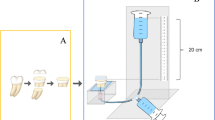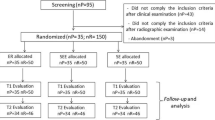Abstract
Purpose
The purpose of this study is to assess the marginal adaptation of cavities restored with a three-step etch-and-rinse adhesive, OptiBond FL (OFL) under different application protocols.
Materials and methods
Twenty-four class V cavities were prepared with half of the margins located in enamel and half in dentin. Cavities were restored with OFL and a microhybrid resin composite (Clearfil AP-X). Three groups (n = 8) that differed in the etching technique were tested with thermomechanical loading, and specimens were subjected to quantitative marginal analysis before and after loading. Micromorphology of etching patters on enamel and dentin were observed with SEM. Data was evaluated with Kruskal–Wallis and Bonferroni post hoc test.
Results
Significantly lower percent CM (46.9 ± 19.5) were found after loading on enamel in group 3 compared to group 1 (96.5 ± 5.1) and group 2 (93.1 ± 8.1). However, no significant differences (p = 0.30) were observed on dentin margins.
Conclusions
Etching enamel with phosphoric acid but avoiding etching dentin before the application of OFL, optimal marginal adaptation could be obtained, evidencing a self-etching primer effect.
Clinical relevance
A reliable adhesive interface was attained with the application of the three-step etch-and-rinse OFL adhesive with a selective enamel etching, representing an advantage on restoring deep cavities.






Similar content being viewed by others
References
Ermis R, De Munck J, Cardoso M, Coutinho E, Van Landuyt K, Poitevin A, Lambrechts P, Van Meerbeek B (2008) Bond strength of self-etch adhesives to dentin prepared with three different diamond burs. Dent Mater 24:978–985
Hamouda I, Samra N, Badawi M (2011) Microtensile bond strength of etch and rinse versus self-etch adhesive systems. J Mech Behav Biomed Mater 4:461–466
Pashley DH, Tay F, Breschi L, Tjäderhane L, Carvalho R, Carrilho M, Tezvergil-Mutluay A (2011) State of the art etch-and-rinse adhesives. Dent Mater 27:1–16
Peumans M, De Munck J, Van Landuyt KL, Kanumilli P, Yoshida Y, Inoue S, Lambrechts P, Van Meerbeek B (2007) Restoring cervical lesions with flexible composites. Dent Mater 23:749–754
Peumans M, De Munck J, Van Landuyt K, Poitevin A, Lambrechts P, Van Meerbeek B (2012) A 13-year clinical evaluation of two three-step etch-and-rinse adhesives in non-carious class-V lesions. Clin Oral Investig 16:129–137
De Munck J, Van Landuyt K, Peumans M, Poitevin A, Lambrechts P, Braem M, Van Meerbeek B (2005) A critical review of the durability of adhesion to tooth tissue: methods and results. J Dent Res 84:118–132
Van Landuyt KL, Mine A, De Munck J, Jaecques S, Peumans M, Lambrechts P, Van Meerbeek B (2009) Are one-step adhesives easier to use and better performing? Multifactorial assessment of contemporary one-step self-etching adhesives. J Adhes Dent 11:175–190
Van Meerbeek B, Kanumilli P, De Munck J, Van Landuyt K, Lambrechts P, Peumans M (2004) A randomized, controlled trial evaluating the three-year clinical effectiveness of two etch & rinse adhesives in cervical lesions. Oper Dent 29:376–385
Mine A, De Munck J, Van Landuyt KL, Poitevin A, Kuboki T, Yoshida Y, Suzuki K, Lambrechts P, Van Meerbeek B (2008) Bonding effectiveness and interfacial characterization of a HEMA/TEGDMA-free three-step etch&rinse adhesive. J Dent 36:767–773
Söderholm KJ (2007) Dental adhesives … How it all started and later evolved. J Adhes Dent 9:227–230
Frankenberger R, Lohbauer U, Roggendorf MJ, Naumann M, Taschner M (2008) Selective enamel etching reconsidered: better than etch-and-rinse and self-etch? J Adhes Dent 10:339–344
Ikeda M, Tsubota K, Takamizawa T, Yoshida T, Miyazaki M, Platt JA (2008) Bonding durability of single-step adhesives to previously acid-etched dentin. Oper Dent 33:702–709
Lührs A-K, Guhr S, Schilke R, Borchers L, Geurtsen W, Günay H (2008) Shear bond strength of self-etch adhesives to enamel with additional phosphoric acid etching. Oper Dent 33:155–162
Taschner M, Nato F, Mazzoni A, Frankenberger R, Krämer N, Di Lenarda R, Petschelt A, Breschi L (2010) Role of preliminary etching for one-step self-etch adhesives. Eur J Oral Sci 118:517–524
Van Meerbeek B, Yoshihara K, Yoshida Y, Mine A, De Munck J, Van Landuyt KL (2011) State of the art of self-etch adhesives. Dent Mater 27:17–28
Watanabe T, Tsubota K, Takamizawa T, Kurokawa H, Rikuta A, Ando S, Miyazaki M (2008) Effect of prior acid etching on bonding durability of single-step adhesives. Oper Dent 33–4:426–433
Bortolotto T, Ferrari M, Onisor I, Tay F, Krejci I (2007) Degradation of thermo-mechanically loaded adhesive class V restorations after 18 months of water storage. Am J Dent 20:83–89
Krejci I, Kuster M, Lutz F (1993) Influence of dentinal fluid and stress on marginal adaptation of resin composites. J Dent Res 72:490–495
Perdigao J, Lambrechts P, Van Meerbeek B, Vanherle G, Lopes AL (1995) Field emission SEM comparison of four postfixation drying techniques for human dentin. J Biomed Mater Res 29:1111–1120
Van Meerbeek B, Perdigão J, Lambrechts P, Vanherle G (1998) The clinical performance of adhesives. J Dent 26:1–20
Frankenberger R, Strobel WO, Kramer N, Lohbauer U, Winterscheidt J, Winterscheidt B, Petschelt A (2003) Evaluation of the fatigue behavior of the resin–dentin bond with the use of different methods. J Biomed Mater Res B Appl Biomater 67:712–721
Heintze SD (2007) Systematic reviews: I. The correlation between laboratory tests on marginal quality and bond strength. II. The correlation between marginal quality and clinical outcome. J Adhes Dent 9:77–106
Van Landuyt KL, Snauwaert J, De Munck J, Peumans M, Yoshida Y, Poitevin A, Coutinho E, Suzuki K, Lambrechts P, Van Meerbeek B (2007) Systematic review of the chemical composition of contemporary dental adhesives. Biomaterials 28:3757–3785
Bayne SC, Schmalz G (2005) Reprinting the classic article on USPHS evaluation methods for measuring the clinical research performance of restorative materials. Clin Oral Invest 9:209–214
Frankenberger R, Krämer N, Lohbauer U, Nikolaenko SA, Reich SM (2007) Marginal integrity: is the clinical performance of bonded restorations predictable in vitro? J Adhes Dent 9:107–116
Heintze SD, Blunck U, Göhring TN, Rousson V (2009) Marginal adaptation in vitro and clinical outcome of class V restorations. Dent Mater 25:605–620
Buonocore G, Wileman W, Brudevold F (1956) A report on a resin composition capable of bonding human dentin surfaces. J Dent Res 35:846–851
Dietschi D, Herzfeld D (1998) In vitro evaluation of marginal and internal adaptation of class II resin composite restorations after thermal and occlusal stressing. Eur J Oral Sci 106:1033–1042
Erickson RL, Barkmeier WW, Latta MA (2009) The role of etching in bonding to enamel: a comparison of self-etching and etch-and-rinse adhesive systems. Dent Mater 25:1459–1467
Frankenberger R, Krämer N, Petschelt A (2000) Long-term effect of dentin primers on enamel bond strength and marginal adaptation. Oper Dent 25:11–19
De Munck J, Van Meerbeek B, Yudhira R, Lambrechts P, Vanherle G (2002) Micro-tensile bond strenght of two adhesives to Erbium: YAG-lased vs. bur-cut enamel and dentin. Eur J Oral Sci 110:322–329
Rathke A, Alt A, Gambin N, Haller B (2007) Dentin diffusion of HEMA released from etch-and-rinse and self-etch bonding systems. Eur J Oral Sci 115:510–516
Costa CA, Giro EM, Do Nascemento AB, Teixeira HM, Hebling J (2003) Short-term evaluation of the pulpo-dentin complex response to a resin-modified glass-ionomer cement and a bonding agent applied in deep cavities. Dent Mater 19:739–746
De Souza Costa CA, Do Nascimento ABL, Teixeira HM (2002) Response of human pulps following acid conditioning and application of a bonding agent in deep cavities. Dent Mater 18:543–551
Pegado RE, Do Amaral FL, Flório FM, Basting RT (2010) Effect of different bonding strategies on adhesion to deep and superficial permanent dentin. Eur J Dent 4:110–117
Armstrong SR, Vargas MA, Chung I, Pashley DH, Campbell JA, Laffoon JE, Qian F (2004) Resin-dentin interfacial ultrastructure and microtensile dentin bond strenght after five-year water storage. Oper Dent 29:705–712
Caiado AC, de Goes MF, de Souza-Filho FJ, Rueggeberg FA (2010) The effect of acid etchant type and dentin location on tubular density and dimension. J Prosthet Dent 103:352–361
Pashley DH, Ciucchi B, Sano H, Carvalho RM, Russell CM (1995) Bond strength versus dentine structure: a modelling approach. Arch Oral Biol 40:1109–1118
Acknowledgments
The authors wish to express their gratitude to Marie-Claude Raymond for the help with the SEM evaluation.
Conflict of interest statement
The authors declare that they have no conflict of interest.
Author information
Authors and Affiliations
Corresponding author
Rights and permissions
About this article
Cite this article
Bahillo, J., Roig, M., Bortolotto, T. et al. Self-etching aspects of a three-step etch-and-rinse adhesive. Clin Oral Invest 17, 1893–1900 (2013). https://doi.org/10.1007/s00784-012-0878-y
Received:
Accepted:
Published:
Issue Date:
DOI: https://doi.org/10.1007/s00784-012-0878-y




